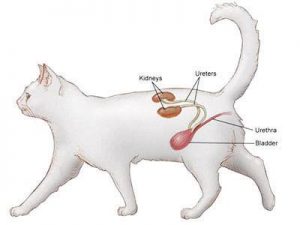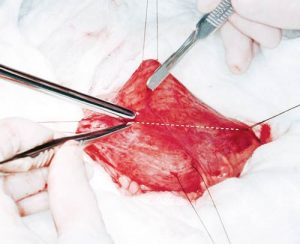 Firstly let’s be crystal clear on this – a cat that can’t pee is going to die unless immediate veterinary care is sought. Urethral blockage is one of the most common feline emergencies that we see at Sunset Vet and therefore it is vital that cat owners are aware of this condition and can identify it early when it happens, before it is too late.
Firstly let’s be crystal clear on this – a cat that can’t pee is going to die unless immediate veterinary care is sought. Urethral blockage is one of the most common feline emergencies that we see at Sunset Vet and therefore it is vital that cat owners are aware of this condition and can identify it early when it happens, before it is too late.
As an anatomical reminder, one of the jobs of the kidneys is to filter unwanted toxins from the blood and pass this waste product, via the ureters, into the bladder for excretion via urination. Once the bladder has filled up enough, receptors in the bladder wall send a signal to the brain that the animal needs to pee, and the bladder muscle contracts to push the urine out through the urethra (via the penis in males and the vagina in females).
If the urethra becomes blocked and the animal is unable to pee, not only is it excruciatingly painful but it will also result in a dangerous build-up of electrolytes and metabolic by-products that result in multiple organ failure. Whilst the kidneys will be severely damaged by the backing up of urine and resulting ‘azotemia’ (medical terminology for increased urea levels in the blood), the most dangerous effect of a urinary blockage is the effect of the build-up of potassium on the heart. High levels of potassium in the blood cause the heart rate to slow down and will eventually lead to cardiac arrest.
Dogs can also present with urinary blockages, but it is much more common in male cats, largely due to the narrowing of the urethra when it bends sharply around the penile bone. For simplicity this article will focus on the phenomenon of urethral blockages in male cats.
How does the urethra become blocked?
- the formation of a urinary mineral stone (‘urolith’) in the bladder which is then peed out into the urethra and gets lodged on the way
- the formation and lodging of urinary grit/sludge, or a mucosal plug secreted from an inflamed bladder wall or urethral lining
- the formation of a blood clot resulting from bleeding within the urinary tract
- the development of a urethral stricture (essentially scar tissue) which narrows the diameter of the urethra resulting in an obstruction
- spasm of the urethral muscle, which can also narrow the urethral diameter
- a tumour arising either from within the urethra itself or from a structure surrounding the urethra which compresses it from the outside
Are all cats at risk of this condition?
Although all male cats (and dogs) can potentially develop urethral obstruction, there are a number of predisposing factors that make it more likely.
- Male cats are at higher risk than female cats, due to the sharp bend of the urethra at the base of the penis
- Overweight cats are at greater risk
- Cats that eat only or mostly dry food are at greater risk than those that eat exclusively wet food (wet food
increases the water intake; however wet food only has other negative effects such as dental disease so it’s a trade-off)
- Cats that have previously had a urethral obstruction are at increased risk of obstructing again, especially if their diet has remained the same
- Cats with recurrent cystitis (bladder wall inflammation) are at increased risk of urethral obstruction.
- Stress (e.g. moving home, home renovations, new baby, stray cat in your garden etc) also increases the risk of urethral obstruction.
- Neutered cats and those that are indoor-only also appear to be at greater risk, though this could be linked to the greater likelihood of obesity in cats following sterilisation
 How do I know if my cat has a urethral obstruction?
How do I know if my cat has a urethral obstruction?
The clinical signs your cat shows depends largely on how long it has been blocked for. The earlier you recognise it and intervene medically, the better chance of a complete recovery, the less pain your cat will go through and the lower your vet bill will be!
Here we list the signs in more or less early to late order.
- Frequent trips to the litter box,
- Straining to pee for a long period of time
- Straining to pee but nothing coming out, or just a few spots
- Being more vocal than usual, constant meowing
- Licking their penis excessively
- Loss of appetite
- Drinking more than usual all of a sudden
- Vomiting
- Signs of abdominal pain, such as crying when you pick them up or showing aggression that is out of character
- Hiding
- Collapse
- Becoming comatose
Remember, a cat can die if it is has an untreated urethral obstruction for just 24 hours! Unfortunately there are no ‘home remedies’ for this condition, so a trip to the vet is an absolute must.
What will happen at the vet if my cat has urethral obstruction?
 Firstly the vet will want to confirm that this is indeed a blocked bladder. A gentle palpation of the abdomen will reveal usually a rock hard grapefruit sized bladder, as sure sign of urethral obstruction.
Firstly the vet will want to confirm that this is indeed a blocked bladder. A gentle palpation of the abdomen will reveal usually a rock hard grapefruit sized bladder, as sure sign of urethral obstruction.
Your cat will likely need to be hospitalised for several days in order to unblock it as the goal is not only to empty the bladder but also to stabilise the cat, treat the acute kidney failure and potentially life threatening increased potassium in the blood, identify why it blocked in the first place and remove that cause if for example it is due to a bladder stone.
Usually a short acting sedative is given, and the vet will pass a urinary catheter up the penis, suturing it in place with a closed collection system. The bladder is flushed and samples are taken to look for crystals. Xrays may be taken to identify bladder stones, and if they are present, surgery may be required to remove them.
Sunset Vet offers veterinary services via their Kuta (24hr) and Ubud (8am-10pm) clinics. For further information or to make an appointment call them on 03619348915 (Kuta) or 0361975296 (Ubud), or visit www.sunsetvetbali.com or www.facebook.com/sunsetvetbali or Instagram: sunset_vet_bali
Copyright © 2018 Bali Advertiser
You can read all past articles of Pet Care at www.BaliAdvertiser.biz